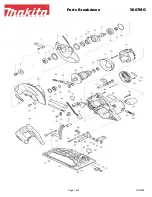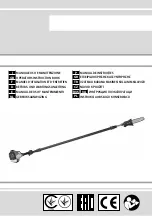
only enough pressure to keep the saw cutting. Let the blade do the work. The use of excessive pressure that
causes bending or twisting of the blade and may break it.
4.8 PLUNGE CUTTING
Mark the line of cut clearly. Choose a convenient starting point inside the area to be cut out and place the tip of
the blade over that point. Rest the front edge of shoe assembly on the workpiece and hold firmly in position.
Depress the lock off button then pull the ON/OFF trigger to start the cutting.
Make sure that blade does not touch work until motor reaches full speed, since this could cause loss of control
resulting in serious injury.
With blade at full cutting speed, slowly tilt saw downward until the blade starts cutting. After blade penetrates the
workpiece, tilt saw until blade is perpendicular to the workpiece.
WARNING: Blade longer than 15cm can whip and should not be used for plunge cutting. Failure to heed this
warning can result in serious personal injury.
Cutting into electrical wiring can cause the blade, blade clamp and the saw assembly to become electrically live.
Do not touch metal part parts when cutting into a wall. Grasp only the insulated surfaces on the tool. make sure
the hidden electrical wiring, water pipes, and mechanical hazrds are not in the blade path when cutting into a wall.
4.9 METAL CUTTING
You may cut metal such as sheet steel, pipe, steel rod, aluminium, brass and copper with this tool by using the
appropiate cutting blade (do not use the provided blade but buy a blade for metal cutting matching with this tool).
When metal cutting:
-
Do not twist or ben the blade
-
Do not force the tool and use a slow speed setting
-
Use a cutting oil when cutting soft metal and steel. Cutting oil also keeps the blade cool, increases cutting
action and prolongs blade life.
-
Never use gasoline since normal sparkling of motor could ignite fumes.
-
Clamp the workpiece firmly and cut close to the clamping point to eliminate any vibration of the workpiece.
When cutting conduit pipe or angle iron, clamp the workpiece in a vice if possible and cut close to the vice.
To cut thin sheet material, “sandwich” the matrial between hardboard or plywood and clamp the layers to
eliminate vibration and material tearing.
5. MAINTENANCE AND STORAGE
a. Maintenance
-
After use and before cleaning and maintenance, remove the blade and the battery form the tool.
-
Clean the housing only with a damp cloth. Do not use solvents! Then wipe thoroughly.
-
Check the condition of the tool. If the tool is damaged or has malfunction, do not use it and bring it to a
qualified service for inspection or reparation.
-
To maintain the optimum battery power, we recommend that the battery be discharged and recharged every
two months.
b. Storage
Remove the battery from the tool.
Store the tool in
a dry place and protected from freezing, the ambient temperature should not exceed 50◦c. Put it
out of the reach of children.
11


































